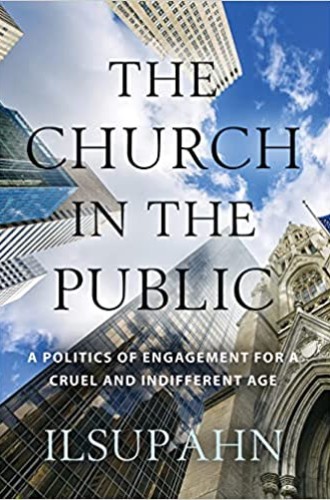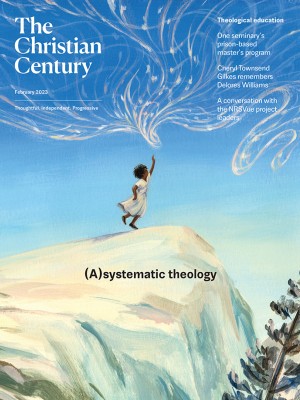Church vs. injustice, not church vs. state
Ilsup Ahn believes that a different conception of church could have stopped, among other things, housing segregation.
The central argument in Ilsup Ahn’s wonderfully truthful book is straightforward: “The public is a new sacred space for the church’s ministry of justice and peace.” The church’s place is not on one side of the dualistic church-state divide. The church is neither a religious nor a political movement. Rather, it is a public movement that transcends both private organizations and government authority by building and extending what Ahn calls “rhizomatic relationships” based on justice.
Ahn’s concern is the privatization of the Christian faith that results from its depoliticization, which in turn comes from the church’s being understood primarily as one side of the separation of church and state. Such a privatized church has by and large focused on individual morality and the salvation of the soul rather than on social and ecclesial activism organized to serve as “resistance . . . to an unjust system and structural process.”
Read our latest issue or browse back issues.
Essentially, Ahn argues that the separation of church and state is not what we should prioritize. Although much of the Western church has lost its way, complicit as it is in the assumptions and power dynamics of colonialism and neoliberalism, it can recover its core communal identity as God’s covenantal people by adopting a new political-theological paradigm: the church versus structural injustice.
The middle chapters of Ahn’s book are a tour de force implementation of one notable aspect of the philosophy of social theorists Gilles Deleuze and Félix Guattari. I’ll admit I’m one of those readers who has remained intrigued by the philosophy of these coauthors but bewildered by the actual reading of it. They deploy the concept of the rhizome in their popular A Thousand Plateaus: Capitalism and Schizophrenia. A wonderful bonus of reading Ahn’s book is to come away with a very practical and real-world understanding of Deleuzian rhizomatic theory.
Essentially, rhizomes are nonlinear networks. In biology, these are underground stems. However, unlike the stems we see in arborescent spaces—the aboveground branches that appear as actual trees—rhizomes perform a different set of functions. They store energy and even communicate between multiplicities of networks. Scientists now know that trees talk to each other and may even do so utilizing additional networks like fungi. In communication networks, an example of a rhizome might be hypertext. You click on the hypertext link and it takes you directly to new text somewhere else. The text in which hypertext links are embedded is an example of “arborescent” text.
What does all of this have to do with the public church? Ahn argues that “one of the key features of structural injustice is that it commonly parasitizes the existing arborescent systems, such as governing, regulating, or justifying mechanisms, for its sustenance and growth.” He offers the example of mass incarceration, which has been parasitized by the free market and neoliberalism. Readers can likely think of many other examples in which corporations or other power networks parasitize good things for their own purposes, often in order to appear good themselves.
Ahn’s contention is that the church does not function best as yet one more arborescent network that can be parasitized by structural injustices. The church can do very little if it is just a little tree attempting to challenge neighboring and bigger trees. However, if the church is a rhizomatic assemblage, it can engage multiplicities of networks, deterritorializing the structural injustice of arborescent systems through rhizomatic networking.
If rhizomatic networks are going to effect change, Ahn believes, it is necessary that they move toward the striated arborescent space at a different pace and along pathways not frequently traveled. The example I can’t help but think of is the movement of Frodo and Samwise as they take the ring to the fires of Mount Doom in The Lord of the Rings. They move along hidden lines, often underground, parallel to and infrequently intersecting with the larger movements of men, dwarves, elves, and orcs. There is a weakness, a vulnerability, a self-emptying to this rhizomatic networking. Ahn illustrates this in a chapter on apophatic theology as it relates to rhizomatic politics: “The church, then, exists in the form of apophatic mimesis of or participation in a great mystery of God’s free love, charisms, or ‘divine energy.’”
This way of moving in the world as a public church stands in stark contrast to the way the church has, for the most part, operated in the West. Early in the book, Ahn makes the strong claim that, as a first step, the church must complete “its long-overdue reckoning with the historical sin of colonial complicity.” He argues that the church has not even come close to doing this, and that such a reckoning requires us to take as much time as needed to tell all the stories that need to be told and then work to repair the harm.
Later, as Ahn applies this concept in light of his proposal for a more rhizomatic way of church life, he tells the story of the housing market in the United States over the last century. Quoting Christian ethicist Joe Pettit, Ahn points out that “during the decades of housing apartheid, ‘the White churches of the United States, along with their denominational expressions, were active participants in it, as well as explicit and implicit proponents and beneficiaries of it.’” It was not simply that the church looked the other way as housing discrimination took place. Rather, the explosive growth of the White churches in this period happened exactly in and through housing apartheid. He again quotes Pettit: “White churches were essential to the very organization of suburban life. . . . Had the churches refused to locate in any community that excluded non-Whites, housing apartheid in the United States could not have happened.”
Here Ahn’s philosophical and theological point lands. Only a rhizomatic organizing strategy among the churches in a public manner could have resisted housing apartheid and, as the quote from Pettit illustrates, if the churches had been so organized, housing apartheid would have been averted.
Ahn contends that the future of the Christian church lies in knowing how to visibly and unabashedly be present and lead within the community and public. Having reckoned with past sins and worked toward reparations, the church still has a crucial way forward. The church has a responsibility to overcome its “neutrality and benign complacency to structural injustice and ideological captivity (neoliberalism)” and instead recommit to its rhizomatic role “providing genuine and compassionate care of the ‘least of these,’ and emulating the early Christians’ presence and active participation in the public space.”
This article was edited on January 3, 2022, to attribute two quotations to Joe Pettit.







